So far in August, eight players who have been eligible for either free agency or an extension have signed what we’d traditionally consider maximum-salary contracts, while another three have agreed to extensions worth the maximum they could be offered. Hardly any of these 11 contracts project to be worth the same amounts, providing a case study in just how different a “maximum” NBA contract can look from player to player.
Of all the players who signed maximum-salary contracts this offseason, Leonard has perhaps the most straightforward deal. After he declined his player option for 2021/22 on August 1, the two-time Finals MVP entered free agency as a player with 10 years of NBA experience under his belt. That meant that he qualified for a starting salary worth 35% of the cap, which is the maximum for players with 10+ years of service.
Like all the other contracts on this list, Leonard’s new deal includes 8% annual raises. Here’s what it looks like:
Doncic is entering the fourth year of his rookie scale contract, which made him one of two dozen players eligible for a rookie scale extension this offseason. Typically, an extension for a player with fewer than seven years of NBA experience can only be worth up to 25% of the cap in the first year of the deal. However, a CBA clause known colloquially as the “Rose rule” allows that number to increase to 30%.
Because rookie scale extensions are signed a year early (Doncic’s will begin in 2022/23), it’s rare for a player to have met any of these criteria by the time he signs his deal. For instance, if Doncic had earned his first All-NBA nod in 2020/21, he wouldn’t meet any of the above criteria, since ’20/21 isn’t the “most recent season” before his contract begins — he’d have to do it again in ’21/22 to meet the criteria.
However, because Doncic actually earned All-NBA spots in both 2019/20 and 2020/21, he has already met the required criteria and qualifies for a starting salary worth 30% of the 2022/23 cap. If he doesn’t make the All-NBA team again in ’21/22, he’ll still have done so in two of the three seasons before his extension begins.
| Year |
Salary |
| 2022/23 |
$35,700,000 |
| 2023/24 |
$38,556,000 |
| 2024/25 |
$41,412,000 |
| 2025/26 |
$44,268,000 |
| 2026/27 |
$47,124,000 |
| Total |
$207,060,000 |
Unlike Doncic, Young and Gilgeous-Alexander don’t have any All-NBA berths on their respective résumés, so they aren’t yet eligible for rookie scale extensions worth up to 30% of the 2022/23 cap. However, the Hawks and Thunder didn’t hesitate to go up to the 25% max for their star guards, and both teams are willing to bump that number to 30% if Young or Gilgeous-Alexander make the All-NBA squad in 2021/22.
In other words, while Young or Gilgeous-Alexander could end up having a contract that looks identical to Doncic’s (outlined above), each player is currently on track to earn 25% of a projected $119MM cap in 2022/23, which would mean a starting salary of $29,750,000. Here’s what those new five-year extensions will look like if neither player earns All-NBA honors in 2021/22:
| Year |
Salary |
| 2022/23 |
$29,750,000 |
| 2023/24 |
$32,130,000 |
| 2024/25 |
$34,510,000 |
| 2025/26 |
$36,890,000 |
| 2026/27 |
$39,270,000 |
| Total |
$172,550,000 |
Curry, who had been entering the final year of his contract with the Warriors, agreed to tack on four extra years to that deal, starting in 2022/23. Curry has 12 years of NBA experience, making him eligible for a starting salary worth 35% of the cap.
However, 35% of the projected $119MM cap for 2022/23 is $41.65MM, which is significantly less than the $45,780,966 salary Curry is earning in ’21/22. Because Curry’s previous maximum-salary contract included standard annual raises of 8% and the NBA’s salary cap has increased by less than 8% per year during that time, Curry’s salary has been rising faster than the league-wide maximum has been.
The NBA’s rules won’t require Curry to take a pay cut on his next deal though. If a player is already earning above the league-wide maximum, his personal max is always 105% of his previous salary. That means Curry will be eligible for a 5% raise on this year’s $45,780,966 salary. His extension will begin at $48,070,014 and will look like this:
| Year |
Salary |
| 2022/23 |
$48,070,014 |
| 2023/24 |
$51,915,615 |
| 2024/25 |
$55,761,216 |
| 2025/26 |
$59,606,817 |
| Total |
$215,353,662 |
 Durant’s situation was similar to Curry’s, with a couple minor differences. Like Curry, Durant has a cap hit in 2021/22 ($42,018,900) that exceeds the league-wide max, so his extension will start at 105% of his previous salary.
Durant’s situation was similar to Curry’s, with a couple minor differences. Like Curry, Durant has a cap hit in 2021/22 ($42,018,900) that exceeds the league-wide max, so his extension will start at 105% of his previous salary.
Unlike Curry though, Durant actually had a player option for 2022/23 on his old deal. Because standard veteran extensions are limited to five total years (including the existing contract), KD had two choices — decline his option and add four years, starting in ’22/23, or pick up the option and tack on three years, starting in ’23/24. Because Durant was able to maximize his earnings by turning down the option, he went that route, voiding the option year and signing a four-year extension.
Durant’s contract has one more unusual twist. While his cap hit this coming season is $42,018,900, his base salary is actually just $40,918,900. His deal includes an annual incentive (worth $1.1MM in 2021/22 and increasingly slightly each year) that is considered “likely” to be earned.
It’s possible Durant will miss out on that annual bonus at some point, but it would require a lot to go wrong for the star forward and the Nets. Durant earns the bonus if he meets any one of the following criteria:
- The Nets make the playoffs.
- The Nets win at least 43 games.
- Durant appears in at least 50 games.
- Durant makes the All-Star team.
Taking into account his 5% raise on his 2021/22 cap figures and the separation between base salary and incentives, here’s what Durant’s new extension looks like:
| Year |
Base salary |
Incentives |
Total |
| 2022/23 |
$42,969,845 |
$1,150,000 |
$44,119,845 |
| 2023/24 |
$46,407,433 |
$1,242,000 |
$47,649,433 |
| 2024/25 |
$49,845,021 |
$1,334,000 |
$51,179,021 |
| 2025/26 |
$53,282,609 |
$1,426,000 |
$54,708,609 |
| Total |
$192,504,908 |
$5,152,000 |
$197,656,908 |
Although Butler signed a maximum-salary extension with the Heat, he didn’t get every last dollar he could have. Like Durant, Butler had a player option for 2022/23, and the simplest way to secure the biggest payday would’ve been to decline that option in favor of a new four-year deal that replaced it.
Instead – and it’s possible Miami insisted during the negotiations on taking this route – Butler picked up his $37,653,300 option for 2022/23 and signed a three-year extension that begins in ’23/24.
Based on the NBA’s maximum-salary rules, Butler’s new deal will start at either 120% of his previous salary or 35% of the ’23/24 salary cap, whichever is lesser. A 20% raise on Butler’s $37,653,300 salary for ’22/23 would result in a $45,183,960 salary, but that’s probably unlikely.
In order for $45,183,960 to be less than 35% of the 2023/24 cap, the cap would have to come in at least $129.1MM. We don’t yet have a concrete projection from the NBA for 2023/24, but $129MM+ would be a pretty substantial jump, considering the ’22/23 projection is $119MM. It’s not impossible, but it seems awfully bullish.
Instead then, Butler’s starting salary will likely be worth 35% of the ’23/24 cap. Again, we don’t have a concrete estimate yet, but we’ve been using $125MM as a ballpark figure. Here’s what Butler’s extension would look like if we assume a $125MM cap:
| Year |
Salary |
| 2023/24 |
$43,750,000 |
| 2024/25 |
$47,250,000 |
| 2025/26 |
$50,750,000 |
| Total |
$141,750,000 |
Like Butler, Embiid signed an extension that begins in 2023/24, since he remains under contract for two more seasons (with no options) on his current deal. However, Embiid was able to add an extra year to his new deal, signing a four-year extension.
As we noted within our look at Durant’s deal, a player signing a veteran extension is typically limited to five total years, including the years left on his current contract. But that restriction is loosened a little for players who meet the super-max criteria — their extensions can cover a total of six years. Embiid qualified for the super-max by making the All-NBA Second Team this year, which means he was able to add four years to the two remaining on his current contract, for a total of six.
Again, it’s too early to know exactly what the 2023/24 cap will look like, but Embiid’s extension with the Sixers will start at 35% of that number. If we assume a $125MM cap, the annual breakdown would be as follows:
| Year |
Salary |
| 2023/24 |
$43,750,000 |
| 2024/25 |
$47,250,000 |
| 2025/26 |
$50,750,000 |
| 2026/27 |
$54,250,000 |
| Total |
$196,000,000 |
The eight contracts we’ve covered so far are all technically worth the “maximum salary.” These three fall into a different category.
When a player signs a veteran contract extension, he’s generally eligible to receive up to either 120% of his previous salary (or 120% of the NBA’s estimated average salary) in the first year of his new deal, as long as that amount doesn’t exceed the maximum.
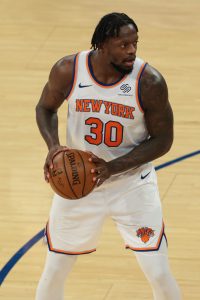 That rule doesn’t apply to someone receiving a rookie scale extension – like Doncic, Young, or Gilgeous-Alexander – or someone signing a super-max extension, like Embiid. And since Curry, Durant, and Butler were all on maximum-salary deals already, that 120% rule likely won’t be relevant for them either (with the possible exception of Butler, as we explained earlier).
That rule doesn’t apply to someone receiving a rookie scale extension – like Doncic, Young, or Gilgeous-Alexander – or someone signing a super-max extension, like Embiid. And since Curry, Durant, and Butler were all on maximum-salary deals already, that 120% rule likely won’t be relevant for them either (with the possible exception of Butler, as we explained earlier).
It does apply to these three players, since they were all earning salaries that are above the league average but well below the maximum. Randle, Rozier, and Smart, who were all entering contract years, signed extensions worth the maximum amount they could be offered right now. That amount is far below the maximum they could have been offered if they’d reached free agency in 2022, which is why these aren’t true max deals.
Let’s take a look at Randle’s situation first, since his contract is the most complex of the three. Like Durant, Randle has incentives in his deal; unlike Durant, Randle has three separate bonuses, two of which are currently considered likely to be earned (appearing in 65+ games and making the All-Star Game) and one that’s considered unlikely to be earned (making the All-Defensive team).
A bonus is deemed to be either “likely” (counting toward the player’s cap hit) or “unlikely” (not counting toward the cap) based on whether it was achieved in the previous season. So, heading into 2021/22, Randle has a base salary of $19.8MM, plus two bonuses worth $990K apiece that are “likely” to be earned, since he played in 71 games and was named an All-Star last year. That bumps his cap hit for this season to $21.78MM.
However, Randle’s new extension with the Knicks doesn’t go into effect until 2022/23, so when that deal begins, it’s possible those incentives will be reclassified — he’d have to play in 65+ games and make the All-Star Game again in 2021/22 for them to remain “likely.”
Randle’s 20% raise for the first year of his extension will apply both to his previous base salary and to his incentives. So his base salary will jump from $19.8MM to $23.76MM in 2022/23, while his total available incentives will increase from $2.97MM to $3.564MM.
Here’s the breakdown of what Randle’s contract should look like (it’s the only one on this list that isn’t yet official, so we’re basing these numbers on the reported terms):
| Year |
Base salary |
Incentives |
Total |
| 2022/23 |
$23,760,000 |
$3,564,000 |
$27,324,000 |
| 2023/24 |
$25,660,800 |
$3,849,120 |
$29,509,920 |
| 2024/25 |
$27,561,600 |
$4,134,240 |
$31,695,840 |
| 2025/26 |
$29,462,400 |
$4,419,360 |
$33,881,760 |
| Total |
$106,444,800 |
$15,966,720 |
$122,411,520 |
The deals for Rozier and Smart are more straightforward, since there are no incentives included.
Here’s Rozier’s extension with the Hornets, which is based on 120% of his $17,905,263 salary for 2021/22:
| Year |
Salary |
| 2022/23 |
$21,486,316 |
| 2023/24 |
$23,205,221 |
| 2024/25 |
$24,924,126 |
| 2025/26 |
$26,643,031 |
| Total |
$96,258,694 |
And here’s Smart’s new deal with the Celtics, based on 120% of his $14,339,285 salary for ’21/22:
| Year |
Salary |
| 2022/23 |
$17,207,142 |
| 2023/24 |
$18,583,713 |
| 2024/25 |
$19,960,284 |
| 2025/26 |
$21,336,855 |
| Total |
$77,087,994 |
There are no shortage of players around the NBA on maximum-salary contracts, but the deals signed this August are a reminder that not all max-salary deals are created equal.
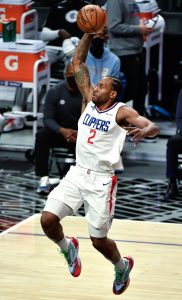
 Durant’s situation was similar to Curry’s, with a couple minor differences. Like Curry, Durant has a cap hit in 2021/22 ($42,018,900) that exceeds the league-wide max, so his extension will start at 105% of his previous salary.
Durant’s situation was similar to Curry’s, with a couple minor differences. Like Curry, Durant has a cap hit in 2021/22 ($42,018,900) that exceeds the league-wide max, so his extension will start at 105% of his previous salary. That rule doesn’t apply to someone receiving a rookie scale extension – like Doncic, Young, or Gilgeous-Alexander – or someone signing a super-max extension, like Embiid. And since Curry, Durant, and Butler were all on maximum-salary deals already, that 120% rule likely won’t be relevant for them either (with the possible exception of Butler, as we explained earlier).
That rule doesn’t apply to someone receiving a rookie scale extension – like Doncic, Young, or Gilgeous-Alexander – or someone signing a super-max extension, like Embiid. And since Curry, Durant, and Butler were all on maximum-salary deals already, that 120% rule likely won’t be relevant for them either (with the possible exception of Butler, as we explained earlier).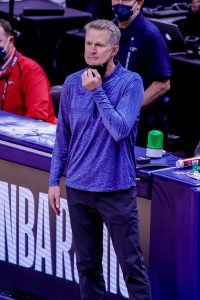 Steve Kerr, Warriors: May 2014
Steve Kerr, Warriors: May 2014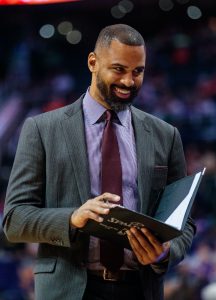
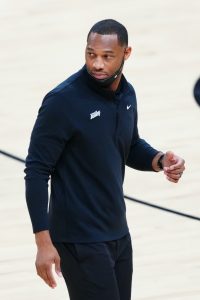
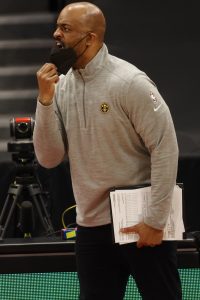
 Golden State Warriors:
Golden State Warriors: 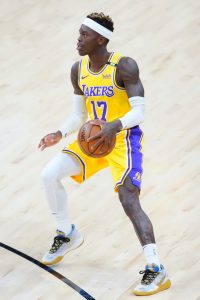 Boston Celtics
Boston Celtics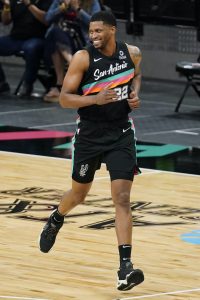 Utah Jazz
Utah Jazz